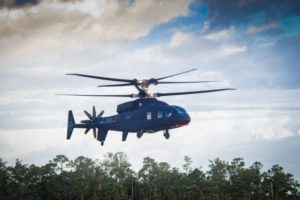Sikorsky [LMT] and Boeing’s [BA] SB-1 Defiant coaxial helicopter reached speeds over 100 knots during its latest flight demonstration, as the two companies prepare for an Army downselect decision in March to continue forward in the Future Long Range Assault Aircraft (FLRAA) program.
The Jan. 13 test flight arrives as the Sikorsky-Boeing team continues to showcase their aircraft’s technological capacity and as senior Army officials have affirmed the goal to push ahead with the program despite potential disparities in competitors’ flight hours.

SB-1 Defiant and Bell’s [TXT] V-280 tiltrotor aircraft have been participating in the Joint Multi-Role Technology Demonstrator program to inform final requirements for FLRAA, intended to replace the Army’s UH-60 Black Hawk helicopters. The JMR-TD program officially wrapped in the fall, while each company has continued test flights to demonstrate capabilities.
Bell told reporters recently the company successfully completed an autonomous test flight with the V-280 in December. The announcement was provided after a manned test flight in front of Army officials and the media where aircraft demonstrated speeds up to 200 knots. (Defense Daily, Jan. 9).
A video posted on Friday shows the SB-1 Defiant a bank of turn at 30-degree angles and flying at over 100 knots at Sikorsky’s Development Flight Test Center in West Palm Beach, Florida.
While V-280 has been flying for two years and been in the air for over 160 hors, Defiant only took its first flight last March after a series of program delays and engineering tweaks.
Army Secretary Ryan McCarthy told reporters last week the service must continue to push ahead with FLRAA despite the disparity in flight hours between the two JMR-TD participants (Defense Daily, Jan. 10).
“Now, because one competitor has more [flight] hours versus another, we’re going to evaluate the design and how all of them have flown. Hours on a prototype is one variable in a massive equation when making a decision,” McCarthy said last week. “That’s one aspect of this competition. By no means does that declare a victor.”